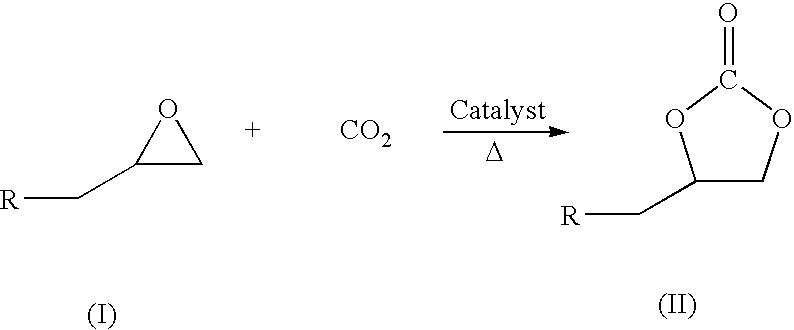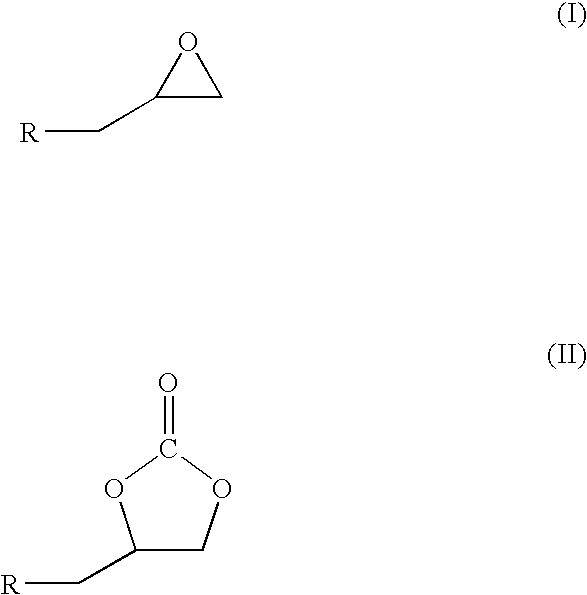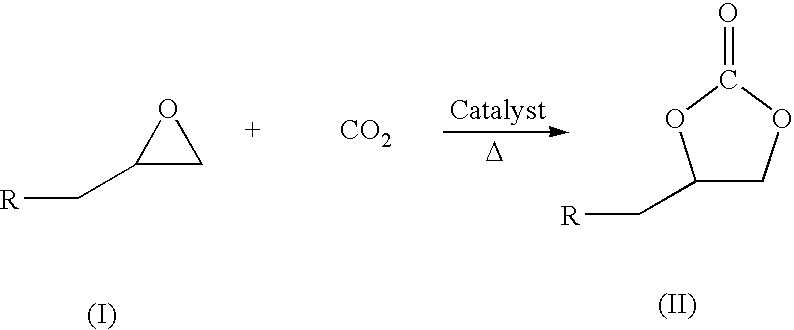Process for preparation of cyclic carbonate
a technology of cyclic carbonate and cyclic carbonate, which is applied in the field of process for the preparation of cyclic carbonate, can solve the problems of high temperature/pressure, difficulty in separating the catalyst after the reaction for reuse, etc., and achieves the effect of short duration tim
- Summary
- Abstract
- Description
- Claims
- Application Information
AI Technical Summary
Benefits of technology
Problems solved by technology
Method used
Image
Examples
example 1
[0022]This is an example of preparation in which a solution of Na2WO4.2H2O (127 g, 0.38 mol) in water (350 cm3) heated at 80-85° C. and vigorously stirred, treated with 14 mol dm−3 nitric acid (25 cm3, 0.35 mol) until the precipitate formed dissolved entirely, then, a solution of zinc nitrate hexahydrate (29.8 g, 0.10 mol) in water (100 cm3) was added with continuous stirring and heating at 90-95° C. The solution is filtered and recrystallized from water.
example 2
[0023]This is an example of a typical reaction in which a stainless steel autoclave equipped with over head stirrer and gas inlet, outlet pipes and pressure gauge charged with 0.0027 mmol of Zinc-substituted polyoxometalate, 3 moles equivalent dimethyl aminopyrdine, hexadecane (internal standard for GC analysis), different mmol equivalents of epichlrohydrine (epoxide) as given in Table (1) herein below and 10 ml of CH2Cl2. After purging with CO2, the reaction mixture was pressurized to 60 psig and heated to temperature 100° C. The overhead stirring speed was around 400 rpm. The course of the reaction was monitored by taking samples repeatedly, and determining the residual content as well as the cyclic carbonate formation by GC, IR, NMR and GC-MS. The reaction is completed at 24 hrs at this temperature except for the 135 mmol equivalent epoxide reaction where the completion of reaction needed nearly 29 hrs. During the entire course of the reaction selectivity remains more than 95%. Q...
example 3
[0025]This is an example of a typical reaction in which a stainless steel autoclave equipped with over head stirrer and gas inlet, outlet pipes and pressure gauge charged with 0.0027 mmol of Zinc-substituted polyoxometalate catalyst, 3 moles equivalent dimethyl aminopyridine, hexadecane (internal standard for GC analysis), 27 mmol equivalent of epichlorohydrine (epoxide) and 10 ml of CH2Cl2. After purging with CO2, the reaction mixture was pressurized to 60 psig and heated to different temperature range 100-150° C. and the results are as given in Table (2) herein below. The course of the reaction was monitored by repeatedly taking samples and determining the residual content as well as the cyclic carbonate formation by GC, IR, NMR and GC-MS. The time required for complete epoxide conversion decreases with increasing temperature.
[0026]
TABLE (2)Con-Catalyst,Epoxide,Temp,Time,version,Selectivity,S. No.mmolmmol° C.hrsmol %mol %10.002727.010024 9997.820.002727.012089996.530.002727.014039...
PUM
| Property | Measurement | Unit |
|---|---|---|
| pressure | aaaaa | aaaaa |
| temperature | aaaaa | aaaaa |
| pressure | aaaaa | aaaaa |
Abstract
Description
Claims
Application Information
 Login to View More
Login to View More - R&D
- Intellectual Property
- Life Sciences
- Materials
- Tech Scout
- Unparalleled Data Quality
- Higher Quality Content
- 60% Fewer Hallucinations
Browse by: Latest US Patents, China's latest patents, Technical Efficacy Thesaurus, Application Domain, Technology Topic, Popular Technical Reports.
© 2025 PatSnap. All rights reserved.Legal|Privacy policy|Modern Slavery Act Transparency Statement|Sitemap|About US| Contact US: help@patsnap.com



